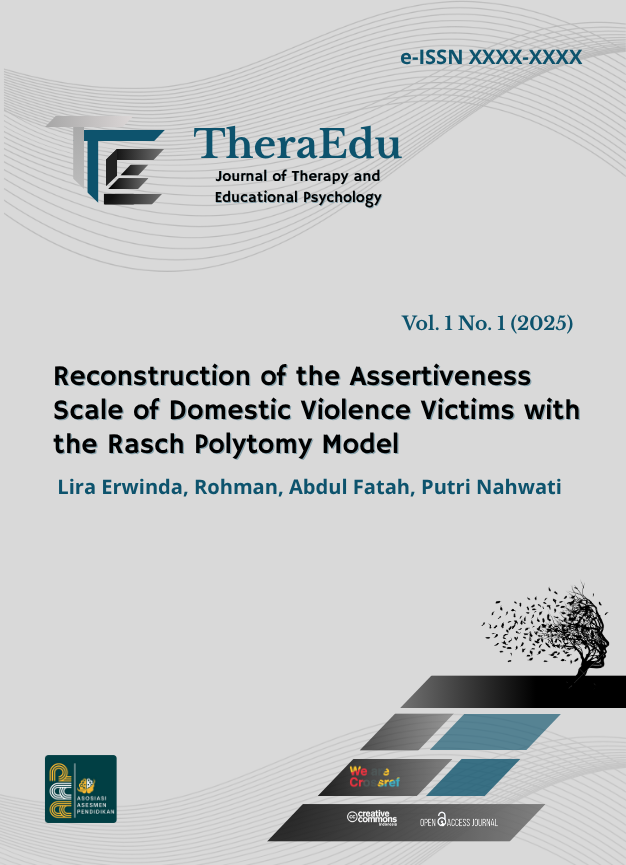Reconstruction of the Assertiveness Scale of Domestic Violence Victims with the Rasch Polytomy Model
DOI:
https://doi.org/10.63203/021817800Keywords:
Assertive, Violence, Rasch, Validity, ReliabilityAbstract
The ability to be assertive is an important aspect in the life of every individual, including for women who are victims of domestic violence (DV). Assertiveness reflects a person's ability to convey thoughts, feelings, and needs honestly and firmly without violating the rights of others. In the context of domestic violence, this ability is often hampered by trauma, emotional dependence, and social pressure. This study aims to explore and describe forms of assertive behavior in women who are victims of domestic violence and to assess the quality of the measurement instruments used. This study involved 64 female respondents who experienced domestic violence, using an assertiveness scale specifically designed to understand psychological dynamics in the context of domestic violence. Data analysis was carried out using the Rasch polytomy model approach with the help of WINSTEPS software version 5.50. The results of the study showed that the instrument used had good validity in identifying various levels of assertiveness, ranging from very low to very high. These findings provide important insights for practitioners, such as counselors, psychologists, and social workers, to set service priorities and design more effective intervention approaches. This study also reinforces the importance of a psychometric approach in developing instruments that are sensitive to the context of gender-based violence.
Downloads
References
Abdurrachman, H. (2010). Perlindungan Hukum Terhadap Korban Kekerasan Dalam Rumah Tangga dalam Putusan Pengadilan Negeri Sebagai Implementasi Hak-Hak Korban. Ius Quia Iustum Law Journal, 17(3), 475-491.
Aisyah, S., & Parker, L. (2014). Problematic conjugations: Women’s agency, marriage and domestic violence in Indonesia. Asian Studies Review, 38(2), 205-223.
Alhabib, S., Nur, U., & Jones, R. (2010). Domestic violence against women: Systematic review of prevalence studies. Journal of family violence, 25(4), 369-382.
Barnish, M. (2004). Domestic violence: A literature review: Summary: HM Inspectorate of Probation.
Boughima, F., Razine, R., Benyaich, H., & Mrabet, M. (2018). The profile of women victims of domestic violence in Morocco. La Revue de Médecine Légale, 9(3), 96-102.
Browne, A., Salomon, A., & Bassuk, S. S. (1999). The impact of recent partner violence on poor women's capacity to maintain work. Violence against women, 5(4), 393-426.
Brush, L. D. (1989). Violent acts and injurious outcomes in married couples: new data from the National Survey of Families and Households.
Bunge, V. P., & Locke, D. (2000). Family violence in Canada: A statistical profile. Canadian Centre for Justice Statistics, 85.
Campbell, J. C. (2002). Health consequences of intimate partner violence. The lancet, 359(9314), 1331-1336.
Chronister, K. M., Harley, E., Aranda, C. L., Barr, L., & Luginbuhl, P. (2012). Community-based career counseling for women survivors of intimate partner violence: a collaborative partnership. Journal of Career Development, 39(6), 515-539.
Chronister, K. M., & McWhirter, E. H. (2006). An experimental examination of two career interventions for battered women. Journal of Counseling Psychology, 53(2), 151.
Clark, C. J., Silverman, J. G., Shahrouri, M., Everson-Rose, S., & Groce, N. (2010). The role of the extended family in women's risk of intimate partner violence in Jordan. Social science & medicine, 70(1), 144-151.
DeVito, J. A., Clark, D., & Shimoni, R. (2001). Messages: Building interpersonal communication skills: Addison Wesley Longman.
Dillon, G., Hussain, R., Loxton, D., & Rahman, S. (2013). Mental and physical health and intimate partner violence against women: A review of the literature. International journal of family medicine, 2013.
Efendi, F., & Makhfudli, M. (2009). Keperawatan Kesehatan Komunitas: teori dan praktik dalam keperawatan: Salemba Medika.
en Koninkrijksrelaties, M. v. B. Z. (2010). Staat van het bestuur 2010: Den Haag.
Eswaran, M., & Malhotra, N. (2009). Domestic violence in developing countries: Theory and evidence: Mimeo University of British Columbia, British Columbia, Canada.
Ferrante, A., Morgan, F., Indermaur, D., & Harding, R. (1996). Measuring the extent of domestic violence: The Hawkins Press.
Gadd, D., Farrall, S., Dallimore, D., & Lombard, N. (2002). Domestic abuse against men in Scotland: Scottish Executive, Central Research Unit.
Hegarty, K., Hindmarsh, E. D., & Gilles, M. T. (2000). Domestic violence in Australia: definition, prevalence and nature of presentation in clinical practice. The Medical Journal of Australia, 173(7), 363-367.
Johnson, M. P. (2010). A typology of domestic violence: Intimate terrorism, violent resistance, and situational couple violence: Upne.
Johnson, M. P., & Leone, J. M. (2005). The differential effects of intimate terrorism and situational couple violence: Findings from the National Violence Against Women Survey. Journal of family issues, 26(3), 322-349.
Johnson, M. P., Leone, J. M., & Xu, Y. (2008). Gender, intimate terrorism, and situational couple violence in general survey data: The gender debate revisited—again. Paper presented at the annual meeting of the National Council on Family Relations, Little Rock, AR.
Kessler, R. C., Molnar, B. E., Feurer, I. D., & Appelbaum, M. (2001). Patterns and mental health predictors of domestic violence in the United States: results from the National Comorbidity Survey. International journal of law and psychiatry.
Khan, R. I. (2012). Perilaku asertif, harga diri dan kecenderungan depresi. Persona: Jurnal Psikologi Indonesia, 1(2).
Kollar, M., Laura, M., Davis, T. L., Monahan, J. L., Jennifer, A. S., Coles, V. B., … Jessica. (2016). Do as I Say: Using Communication Role-Plays to Assess Sexual Assertiveness Following an Intervention. Health Education & Behavior, 43(6), 691–698.
Kumaladewi, V., & Uyun, Q. (1997). 1 Naskah Publikasi Hubungan Antara Perilaku Asertif Dengan Kepuasan Perkawinan Pada Pasangan Suami Istri. 000, 1–30.
Linacre, J. M., & Wright, B. (2000). Winsteps. URL: http://www. winsteps. com/index. htm [accessed 2013-06-27][WebCite Cache].
Lovihan, M. A., & Kaunang, R. O. (2010). Perbedaan Perilaku Asertif pada Wanita Karir yang Sudah Menikah dengan yang Belum Menikah di Minahasa. Jurnal Inovasi, 7(04).
Mahruliana, N. C., Hariyani, H., & Syahputra, Y. (2020). Problem solving for women victims of domestic violence: Descriptive analysis with JASP based on demographics. Psychocentrum Review, 2(2), 56-68.
Meghan Davidson, M., Nitzel, C., Duke, A., Baker, C. M., & Bovaird, J. A. (2012). Advancing Career Counseling and Employment Support for Survivors: An Intervention Evaluation. Journal of counseling psychology, 59(2), 321-328.
Perempuan, K. (2017). Tergerusnya Ruang Aman Perempuan dalam Pusaran Politik Populisme. Catatan Kekerasan terhadap Perempuan Tahun.
Richards, L., & Baker, A. (2003). Findings from the multi-agency domestic violence murder reviews in London. London: Metropolitan Police.
Richardson, J., Coid, J., Petruckevitch, A., Chung, W. S., Moorey, S., & Feder, G. (2002). Identifying domestic violence: cross sectional study in primary care. Bmj, 324(7332), 274.
Riggs, D. S., Caulfield, M. B., & Street, A. E. (2000). Risk for domestic violence: Factors associated with perpetration and victimization. Journal of clinical psychology, 56(10), 1289-1316.
Schafer, J., Caetano, R., & Clark, C. L. (1998). Rates of intimate partner violence in the United States. American journal of public health, 88(11), 1702-1704.
Schumacher, J. A., Feldbau-Kohn, S., Slep, A. M. S., & Heyman, R. E. (2001). Risk factors for male-to-female partner physical abuse. Aggression and violent behavior, 6(2-3), 281-352.
Seegobin, W. (2002). Caribbean families. International encyclopedia of marriage and family.
Showalter, K. (2016). Women's employment and domestic violence: A review of the literature. Aggression and violent behavior, 31, 37-47.
Smith, R. M. (1995). Using item mean squares to evaluate fit to the Rasch model.
Sorenson, S. B., Upchurch, D. M., & Shen, H. (1996). Violence and injury in marital arguments: risk patterns and gender differences. American journal of public health, 86(1), 35-40.
Stark, E., & Flitcraft, A. H. (1988). Women and children at risk: A feminist perspective on child abuse. International Journal of Health Services, 18(1), 97-118.
Straus, M. A. (2017). Physical violence in American families: Incidence rates, causes, and trends Abused and battered (pp. 17-34): Routledge.
Tjaden, P. G., & Thoennes, N. (2001). Coworker violence and gender: Findings from the national violence against women survey. American Journal of Preventive Medicine, 20(2), 85-89.
van der Put, C. E., Gubbels, J., & Assink, M. (2019). Predicting domestic violence: A meta-analysis on the predictive validity of risk assessment tools. Aggression and Violent Behavior.
van Wijk, N. P. L., & De Bruijn, J. (2012). Risk factors for domestic violence in Curacao. Journal of Interpersonal Violence, 27(15), 3032-3053.
Wahab, R. (2006). Kekerasan dalam Rumah Tangga: Perspektif Psikologis dan Edukatif: Islamic University of Indonesia.
Walby, S., & Allen, J. (2004). Domestic violence, sexual assault and stalking: Findings from the British Crime Survey: Home Office.
Wardani, N. S., Keliat, B. A., & Nuraini, T. (2012). Peningkatan Kemampuan Asertif dan Penurunan Persepsi Melalui Assertive Training Therapy pada Suami dengan Risiko KDRT. Jurnal Keperawatan Indonesia, 15(1), 61–66.

Downloads
Published
How to Cite
Issue
Section
License
Copyright (c) 2025 Erwinda, L., Rohman, R., Fatah, A., & Nahwati, P.

This work is licensed under a Creative Commons Attribution 4.0 International License.




















